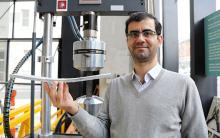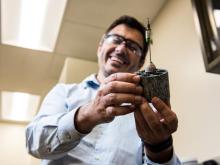Researchers at the University of Michigan are looking at how to make concrete stronger and more flexible. They studied the interior coating (nacre) of abalone shells and found that its composition resembles brick walls. The nacre contains polymer which holds the rigid layers together, at the same time allowing them to slip from one side to another when subjected to stress. This is what makes the nacre both flexible and strong.
With an aim to mimic this effect, they included specially-selected short fibres in the standard concrete mixture comprised of cement, sand, and gravel. As a result, the product can flex under stress from 3% to 7% before damages occur (as opposed to 0.01% for ordinary concrete or mortar). These statistics make a big difference since it increases the concrete’s capacity by 300% to 500%.
Engineered Cementitious Composite (ECC), also known as Strain Hardening Cement-based Composites (SHCC) or simply bendable concrete is a truly revolutionary material. When incorporated into major structures, this concrete is less prone to damages due to natural or man-made disasters.
Bendable concrete has found use in a number of major structures in the USA, Australia, Korea, Japan, and Switzerland. Some of these include:
- The bridge deck on interstate 94 in Michigan
- The Ellsworth Road Bridge in Arizona
- The Mihara Bridge in Hokkaido, Japan
- The Glorio Roppongi high-rise apartment building in Tokyo
- The Mitaka Dam outside Hiroshima
Along with preventing minor structural damages such as cracks and fissures, bendable concrete can also heal itself through continued carbon mineralization and hydration. This should help minimize the need for demolition and reconstruction of simple concrete structures that normally have a tendency to need repairs or replacement over time. This new concrete can also adapt its thermal capacity in order to store more heat during high external temperatures, thus keeping the structure interior cool.
Currently, scientists are testing bendable concrete’s ability to neutralize pollution with an aim to help keep the air in urban areas cleaner.
All these adjustable features and functionalities of bendable concrete can contribute to the development of smart cities in the future. These cities will have a sustainable and resilient infrastructure which adapts to changes in the environment and contributes to healthier living conditions.
Even though bendable concrete offers a number of advantages, experts still have to determine the challenges it would pose for associated trades, like electrical works or plumbing. However, the fact remains that bendable concrete makes structures safer, extends their service life, and lowers maintenance costs.
The background to this research is that today, more than 50% of the world’s population lives in urban areas and this percentage is expected to increase to almost 70% by 2050. People are migrating to the ‘concrete jungle’. Concrete is an indelible part of people’s lives in urban areas. It’s literally everywhere – on the bridges, pavements, and buildings, in our homes, schools, and workplaces. But despite popular belief, concrete is not a strong building material in many instances. In fact, when subjected to stress, concrete cracks easily.
Because of concrete’s brittle nature, it takes only a minor movement for cracks to appear. When it comes to smaller structures, this isn’t usually a serious issue. In these cases, cracks may be easily mended with the use of new concrete. This new concrete will also get damaged in the future and be patched up again. The process is somewhat expensive over the long-term but generally safe.
However, when cracks occur in major structures, the problem becomes serious. Damages of this kind make the structure vulnerable and less resilient to both man-made and natural forces, like bomb blasts in terrorist attacks, tornadoes, or earthquakes, which can result in a catastrophic event.






